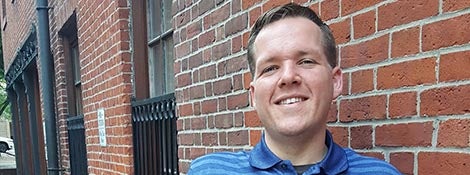
Morgan Pilkenton, polymer class of 2008, is a co-author on the ground-breaking “elastic second skin” research you may have seen in your local paper in early May. Published in Nature Materials, Pilkenton and his associates at Living Proof successfully synthesized an “elastic, wearable crosslinked polymer layer that mimics the properties of normal, youthful skin.” Living Proof, which focuses solely on personal care, eventually spun the technology out to Olivo Labs to pursue the exciting potential in medical applications. The research was done in collaboration wth investigators at Harvard and MIT.
“They had no idea it was going to be this successful,” says Pilkenton, now at FRX Polymers in Boston. “The press is great for them. This will allow them to raise funds and go through the FDA regulatory process.”
The unique polymer they designed has potential applications in everything from cosmetics to drug delivery and wound dressings.
After graduating from the internship program, Pilkenton investigated optical lenses and carbon nanotube composites as a research associate in Dr. Richard Chartoff’s laboratory.
Morgan left Eugene for Arizona to marry the love of his life – and start applying for jobs. Unfortunately, the job market in Arizona was not looking good, so he and his new bride started looking for opportunities elsewhere.
He actually found the job at Living Proof via an online application – no networking involved. “They called me four hours after I applied and said, ‘We love your background; you have to come out.’ A couple of weeks later, I was living in Boston. It all went very very fast.”
“Living Proof was a hair-care company … starting to expand their skin care line.” It might seem odd, he says, that he was drawn to hair care or skin care products in the first place, but Living Proof is very science-oriented. “Their whole shtick is that they’re a science company that makes personal care products.” The company was about 50% R&D when he was there – versus 10% for a typical personal care company, says Pilkenton. “It was a fun Boston start-up. We worked a ton and it was a blast.”
“I helped on the materials optimization to match all the target mechanical properties (matching skin so it’s comfortable when you wear it). I also helped develop the formulation that acts as the delivery vehicle. We took a thick silicone material and turned it into a cream not to dissimilar from a thick moisturizer that could be easily applied. I did the lion’s share of the work developing the cream and a co-worker and I split the work on developing the polymer material and mechanical testing.”
“The development cycle as a whole was that we would do the lab work, develop a new formula and pass it on to our co-workers who would then test it on people. They would provide feedback on how it needed to be improved and then we would optimize it,” says Pilkenton. This back and forth took about two years. The research was exciting. Now that the focus is on getting FDA approval, which is a little less appealing, he’s moved on. “I need to be discovering and creating,” he says.
Now at FRX, Pilkenton is working on flame retardant polymers. “I switched gears, big-time,” he says. In his new role, his focus is on application development – helping companies understand how to use the polymers FRX develops for a specific end application. Flame retardant polymers are in many consumer products you might expect – everything from computer chips to airplanes. And in some products you might not expect – like wigs. “You don’t want your artificial hair to catch on fire if you’re smoking a cigarette,” Pilkenton points out.
The polymers FRX makes are unique because they’re environmentally friendly. “That’s why we’re in business… Most flame retardants on the market are halogen-based, and those are harsh on the environment. They show up in fish and water – and when they burn, they can turn into toxic gases.” FRX uses phosphorus-based polymers and they don’t show up in the environment; they don’t bioaccumulate, he says. FRX has won several environmental awards, including a 2014 Environmental Merit Award from the EPA.
Looking back, Pilkenton is glad he chose polymers as the playground for his career. As an undergrad, he fell for polymer chemistry because the application of the science was so direct. “I liked polymer chemistry as a topic because you actually made things with it. Real-world tangible goods. That’s what attracted me to it.”
As for the master’s program, “The whole finding a job thing was what drew me to the program,” he says.
And the immersion lab is what really helped him get where he is. “Learning how to create a recipe from the ground up and learning how materials interact with each other to create a product that meets goals – I still used those skills almost every day,” Pilkenton says. “That problem-solving, independent ability to figure it out yourself is something that seems to be missing in a lot of young scientists. That ability really helped me.”
“The master’s program was a big part of why I got the job in Boston… As you can tell, I’m a fan of the program.”
A sampling of news coverage:
